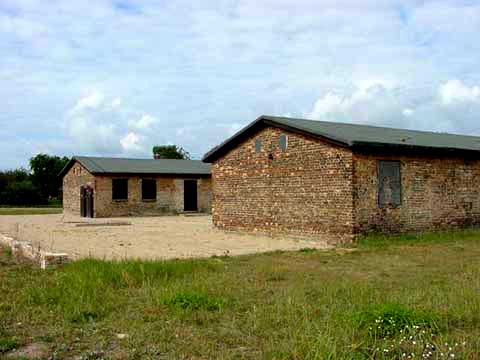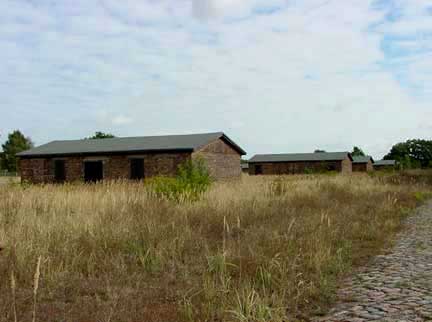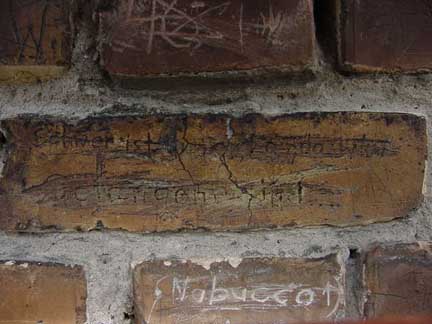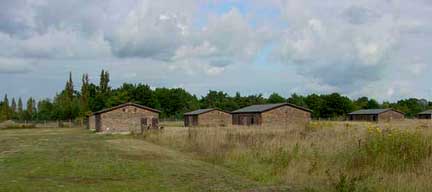Special Camp No. 7 at Sachsenhausen Special Camp No. 7 was the name given to the former Sachsenhausen concentration camp by the Soviet Union when the camp was turned into an internment camp for German prisoners after World War II ended. According to an Information Leaflet available at the Memorial Site, the former Nazi "preventive detention camp" was converted by the Soviet Union into Zone I for German civilians who were arrested and sent to the Sachsenhausen camp without a trial. The former brick barrack buildings, which the Nazis had used as a Special Camp for Allied Prisoners of War, were initially converted into Zone II for Soviet citizens who were awaiting return to the Soviet Union. Some of them were former concentration camp prisoners who were looked upon as traitors to Communism; they were waiting to be sent to the gulags in Siberia. Two of these brick buildings are shown in the photograph above. In August 1945, these brick barracks were used by the occupation forces of the Soviet Union as part of their prison camp for German citizens who had been arrested without charges. The Sachsenhausen Memorial Site has been owned and administered by the Brandenburg Memorials Foundation since 1993. In 1995, the Memorial at Sachsenhausen was expanded to include the area of a former special camp which was built by the Nazis in 1940 outside the triangular prison enclosure; 15 of the original brick barrack buildings in this area have been preserved. Sachsenhausen was liberated by soldiers of the Soviet Union on April 22, 1945; after the war, the camp was located in the Soviet zone of occupation in East Germany. The Soviets set up their internment camps along the lines of the gulag system in the Soviet Union under the Communist dictatorship of Stalin. According to the Information Leaflet: In the Gulags that were created by Lenin and extended into a huge complex by Stalin, millions of people were required to perform forced labor for the development of the Soviet Union. Lawrentij Berija, the head of the Soviet National Commissioner's Office of the Interior (NKVD), had already made provisions by January 1945 to secure the hinterland of the advancing Soviet Army. Members of the German Army and civilians captured by the Red Army during its advance were placed in camps immediately behind the front lines in order to be deported to the Soviet Union. Following the completion of the war negotiations, these camps were replaced by so-called Special Camps that were intended for long-term internment and imprisonment. Within the German territory occupied by the Soviets, ten camps were established, five of which were in Brandenburg. They were not under the authority of the Soviet Military Administration in Germany, but were administered by a department of the NKVD in Moscow.  In 1943 the Allied powers had already started making plans for their occupation of Germany after the war, which by that time they anticipated winning. There were major conferences at Teheran, Moscow and Yalta in 1943 and 1944 where resolutions were passed regarding the means necessary to secure the occupation. On August 2, 1945, these resolutions were confirmed and the details were planned at the Potsdam Conference, held in a suburb of Berlin. By that time, Roosevelt was dead, and President Harry Truman was the one making the decisions at the Potsdam conference, along with Churchill and Stalin. For the first time, France was also included as the fourth victorious power. According to the Potsdam Agreement, the officials of the Nazi party and its organizations, members of the Gestapo, and anyone who might endanger the goals of the occupation were to be interned in concentration camps. Not included were Nazis who might be of use to America, like General Reinhard von Gehlen, the chief of the Nazi spy organization, and Werner von Braun, the head of Germany's V-2 rocket program. The former Nazi concentration camps at Dachau, Buchenwald and Sachsenhausen were converted into internment camps for German political prisoners, while thousands of Nazi scientists were taken to America and the Soviet Union. General Reinhard von Gehlen was sneaked into the United States wearing an American uniform, even before the German surrender, and became part of the new American intelligence agency, called the CIA, after the war. In the first half of 1945, approximately 6,000 German Army officers were released by the Western Allies, but were then arrested by the Soviets and held in Zone II at Sachsenhausen. Later the Zone II barracks were filled with German prisoners who had been sentenced by a Soviet military tribunal to 15 years of hard labor. Until 1950, a large number of German citizens were imprisoned by the Soviet Union and forced to perform slave labor in the gulags of Siberia.  Special Camp No. 7 was originally located in Weesow near Werneuchen, but on August 10, 1945, the first transport of 150 prisoners were transferred to the former Sachsenhausen concentration camp and housed in the 60 wooden barracks which had formerly held the Communist political prisoners of the Nazis. By the end of 1945, the Soviet internment camp had reached its full capacity of 12,000 prisoners, but at times during 1946, up to 16,000 prisoners were crowded into the camp. Approximately 2,000 female prisoners were housed in a separate area of Special Camp No. 7. According to an Information Leaflet available at the Sachsenhausen Memorial Site: The history of the Special Camp of the Soviet Secret Service (NKVD) in Germany must be viewed in light of the circumstances and events of World War II as well as the Soviet camp system (Gulag). The Information Leaflet explains the reason for the camp, from the Communist winner's point of view: The Second World War which the German Reich began in 1939, and the genocide which the Nazis pursued against Jew, Sinti and Roma, and other groups who had been declared racially inferior by the regime, caused widespread misery and destruction of unknown proportions for that time throughout Europe until the end of the war in spring 1945. In spite of the impossibility of winning the world war, which since 1943 had been pursued as a "total war," up to the end the political and military leadership of the "Third Reich" was not prepared to capitulate. The Allies had to militarily overpower National Socialist Germany costing them great losses. Moreover, the propaganda of the Nazi regime conveyed the impression that after Germany was occupied, the National Socialist would continue their struggle against the allied troops with the "Werewolf" organization. According to the same Information Leaflet available at the Sachsenhausen Memorial Site, conditions in Special Camp No. 7 were deplorable, as the following quote explains: Hunger and cold prevailed in the Special Camp. The inadequate hygienic and sanitary conditions and the insufficient nourishment led to disease and epidemics. Usually the barracks were overcrowded; the prisoners had to sleep on the bare wood frames until 1947, when the Soviet camp administration distributed blankets and bags of straw. The only clothing which the prisoners had during their imprisonment was what they were wearing at the time of their arrest. The possession of personal items, particularly books and writing material was strictly forbidden. Violations of these rigid camp regulations, which were for the most part unknown to most of the prisoners, resulted in harsh punishment imposed by the Soviet guard personnel or the German prisoners who held special functions. Unlike the camps in the Soviet Union, the special camps were not work camps. The prisoners suffered much more from forced idleness. This is why the assignment to one of the few work commandos serving the camp's self-sufficiency was regarded as a privilege. The prisoners attempted to at least temporarily escape the monotony of their daily routine in the camps by participating in any activities. Most of them were prohibited, such as lectures, lessons, singing and improving the appearance of the barracks. Only after the first order for releases in 1948 were the conditions alleviated somewhat by the allowance of board games, sports, and occasionally newspapers and radio reports. Several of the brick barracks in Zone II are open to visitors. Inside are TV monitors where one can see videos of interviews with the survivors, who tell about the horrendous conditions in the prison. According to one survivor, the windows of the barracks were blocked out so that the prisoners were kept in almost total darkness. They had to sleep on bare boards with no mattresses and were furnished with only a block of wood for a pillow. There were virtually no prisoners released by the Soviets until 1948 when approximately 5,000 civilian prisoners in Special Camp No. 7 were given "amnesty." After that, some of the internment camps were closed, and Sachsenhausen became the largest camp in the system. At that time, it was renamed Special Camp Number 1. The remaining Special Camps were not closed until the spring of 1950 when approximately 8,000 prisoners were released from Special Camp No. 7 in Sachsenhausen, but a few of the remaining prisoners were sent to the Soviet Union. The NKVD handed over 5,500 prisoners to the East German Communist government, and 550 of them were tried and convicted in the "Waldheimer Trials," which the Information Leaflet says "violated the principles of a constitutional state."  A permanent exhibition on the history of Special Camp No. 7 has now replaced the temporary one formerly located in the Sachsenhausen main Museum. It is housed in a new museum which has been built in the former Zone II, an area which was incorporated into the Sachsenhausen Memorial Site in 1995. The museum building is black granite with no windows; the interior is completely dark with spotlights shining on the displays. I was unable to take any photographs because of the almost total darkness. A small room in the museum has a number of laptop computers which visitors can use to access basic information about the layout of the Sachsenhausen camp. The museum includes a lot of Nazi documents which serve to explain why the Germans received such harsh treatment by the Communists in Special Camp No. 7. This is not a museum devoted to exonerating the victims; it is highly critical of the Nazi regime. The photograph below shows the overhanging roof of the Special Camp No. 7 museum, which is located just outside the triangle which was the prison enclosure. On the right side of the photograph below, one can see the structure which covers the ruined crematorium building and gas chamber. The stone fence, on the left side of the photograph, separates the concentration camp enclosure from Zone II where brick barracks housed first Prisoners of War and then German army officers who became prisoners of the Communist Soviet occupation forces after the war. The monument to the anti-Fascist resistance fighters can be seen in the center of the photograph.  Mass Graves of German victimsTable of ContentsHome |